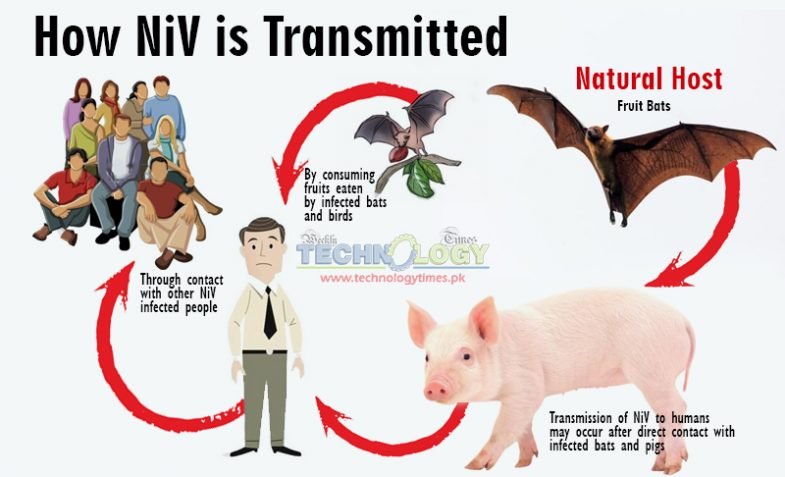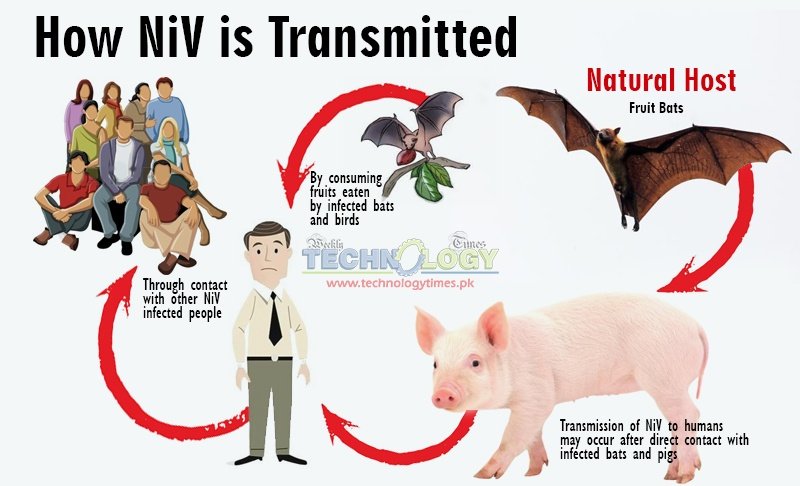Now a days various messages on social media warns Pakistani nation to avoid chicken consumption, because its source of Nipah virus. At Pakistan production of poultry products is very high to fulfill the consumption requirements. For any layperson it is confusing and debatable either chicken is source of Nipah virus or not, mostly said no its fake news, chicken is safe its not the cause of spread, other said avoid the chicken consumption because, prevention is better than cure.

Nipah virus (NiV) infection is a newly emerging zoonosis that causes severe disease in both humans and animals. “Zoonosis means a disease that can be transmitted to humans from animals”. Nipah virus was first identified in Kampung Sungai Nipah, Malaysia in 1998. The pigs were the intermediate hosts during that outbreak. Around 1.1 million pigs had to be killed to control the outbreak. However, it is not necessary to have an intermediate host during Nipah Virus outbreak.
Host
The natural host of the virus is fruit bats of the Pteropodidae Family, the Indian flying fox (Pteropus giganteus), also known as the greater Indian fruit bat, according to WHO. Transmission of Nipah virus takes place through direct contact with infected bats, pigs, or from other NiV-infected people.
As in Pakistan pigs are not common, nor the use of food prepared by segments of pig flesh or blood is available. The only option for source of NiV in humans in Pakistan is the left-over fruits bitten by fruit bats and then consumed by people.
The rumors about NiV spread by chicken through social media is just a fake and false news, spread due to some vested interest.
Dr. Abdur Rehman, Director Poultry Research Institute (PRI), Rawalpindi said that Nipah Virus can not spread through chicken as NiV does not exist in chicken anywhere in the world. He further emphasized that according to the United Nations Organization, Food and Agriculture Organization (FAO) and Center for Disease Control (CDC) of USA had clearly denied the existence of NiV in any animal except pig and fruit bat.
History of Nipah virus
Initially the NiV was isolated and identified in 1998 and 1999 in Malaysia and Singapore. Its name originated because of the village Sungai Nipah, Malaysia. In 2001, it was reported in Siliguri, India and Meherpur District, Bangladesh. Then again it appeared in Bangladesh from 2003 to 2005. Most recently, an outbreak occur in Kozhikode district, Kerala, India.
The countries at risk list issued by World Health Organization, Centres for Disease Control and Prevention include Australia, Cambodia, Thailand, Taiwan, China, Indonesia, Madagascar, Ghana, and the Philippines, but not Pakistan.
Scientists have found that humans often contracted the disease by drinking raw date palm sap tapped directly from trees, a sweet treat that fruit bats also enjoy.
According to Centers for Disease Control and Prevention, infection with Nipah virus is associated with encephalitis (inflammation of the brain). Clinical signs are fever, headache, dizziness and vomiting, followed by drowsiness, disorientation and mental confusion, within three to fourteen days of exposure and an incubation period of five to fourteen days. More than 50 per cent of the patients faced a reduced level of consciousness and prominent brain-stem dysfunction. Some patients have a respiratory illness during the early part of their infections, and half of the patients showing severe neurological signs showed also pulmonary signs.
Conclusion
Nipah virus (NiV) is one of the pathogens in the WHO R&D (Research and Development) Blueprint list of epidemic threats needing urgent R&D attention. From 1998 to 2015, more than 600 cases of Nipah virus (NiV) human infections were reported. Later outbreaks, in India and Bangladesh, have caused death in 43 percent to 100 percent of infected patients. The virus claimed over 300 lives across Malaysia, Singapore, Bangladesh and India between 1998 and 2008, according to WHO.
